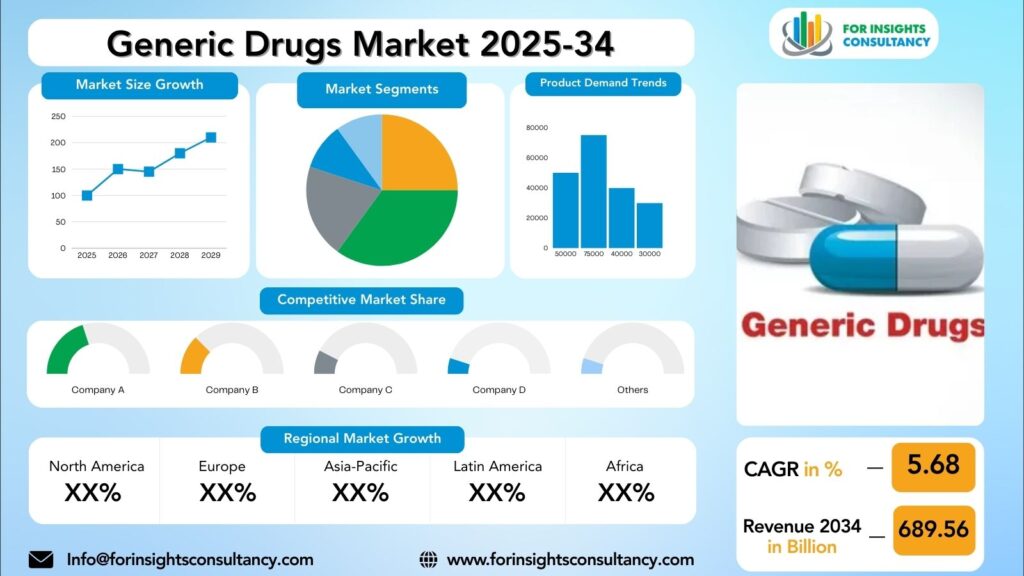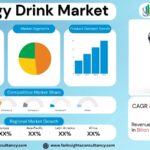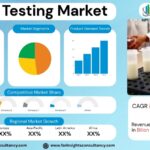
Generic Drugs Market Research Report by Therapeutic Area (Cardiovascular Diseases,Oncology (Cancer), Central Nervous System (CNS) Disorders), By Distribution Channel (Retail Pharmacies, Hospital Pharmacies, Online Pharmacies), By Type of Drug (Specialty Generics, Simple Generics, Branded Generics, Biosimilars), by Route of Administration (Injectables, Oral,Topical/Dermal, Inhalable), by Offering, and Region Global Market Analysis and Forecast, 2025-2034
Aug-2025 Formats | PDF | Category: Pharma | Delivery: 24 to 72 Hours
Generic Drugs Market is forecast to increase from USD 423.78 billion in 2025 to USD 689.56 billion by 2034, at a CAGR of 5.68%.
Generic Drugs Market: A Comprehensive Overview and Future Developments
Generic drugs are pharmaceutical products that are bioequivalent to brand-name drugs in terms of dosage form, strength, quality, performance, and intended use. They are marketed under their chemical name and are often referred to as non-proprietary or off-patent drugs. They contain the same active ingredients as brand-name drugs but are sold at a lower price point, making them more accessible to a wider population.
Regulatory bodies, such as the FDA in the United States, oversee the approval and marketing of generic drugs to ensure patient safety and efficacy. The generic drugs market is expected to grow and innovate in the coming years, with a focus on biosimilars, generic versions of biologic drugs, offering cost savings and increasing access to essential therapies. Advancements in technology, such as artificial intelligence and machine learning, are also expected to streamline the drug development process and enhance the efficiency of generic drug manufacturing.
Generic Drugs Market Dynamics
Growth Drivers
The Generic Drugs Market is driven by cost-effectiveness, patent expirations, regulatory support, and increasing awareness. Generic drugs are typically 80-85% cheaper than brand-name drugs, making them more affordable for patients, healthcare providers, and insurance companies. This has led to increased utilization of generic drugs in various healthcare settings. Patent expirations on brand-name drugs also contribute to the growth of the market, as other pharmaceutical companies can produce generic versions, increasing competition and lower prices. Government regulations and policies, such as the FDA and EMA, have streamlined the approval process for generic drugs, encouraging pharmaceutical companies to invest in their development. As healthcare costs and affordability become more important, more patients and healthcare providers are turning to generic drugs as a cost-effective solution. Awareness campaigns and educational initiatives have helped dispel misconceptions about generic medications and build trust in their safety and efficacy, leading to a significant increase in demand for generic drugs.
Restraints
The generic drugs market faces several challenges, including regulatory challenges, intellectual property rights, quality control, and market fragmentation. Each country has its own regulations and approval processes, which can increase the cost of bringing generic drugs to market and slow down the overall process. To overcome these challenges, industry stakeholders need to work together to harmonize regulations across different regions, streamlining the approval process and promoting collaboration between regulatory bodies.
Intellectual property rights are another significant restraint in the generic drugs market. Brand-name pharmaceutical companies often hold patents on their drugs, preventing generic manufacturers from producing cheaper alternatives until the patents expire. Policymakers need to strike a balance between protecting intellectual property rights and promoting competition in the market. Governments can foster a more competitive landscape by incentivizing the development of generic drugs through measures such as patent expiration extensions and market exclusivity waivers.
Quality control and counterfeiting are also significant challenges. With lower production costs, some manufacturers may cut corners on quality control measures, leading to substandard or counterfeit medications entering the market. To combat this issue, industry stakeholders must prioritize quality control measures and invest in technologies to prevent counterfeiting.
Market fragmentation presents a challenge as numerous manufacturers compete, leading to reduced profit margins and hindering investment in research and development. To overcome market fragmentation, industry players need to focus on differentiation and innovation. By investing in value-added generic drugs with unique formulations or delivery systems, manufacturers can differentiate themselves from competitors and command higher prices. Collaborative efforts between manufacturers and healthcare providers can help identify unmet market needs and drive innovation in generic drug development.
Opportunities
The generic drugs market is a growing segment of the pharmaceutical industry, offering a wide range of products that are bioequivalent to brand-name drugs in terms of dosage form, strength, administration route, quality, performance characteristics, and intended use. These drugs are typically marketed after the expiration of patents held by the original manufacturer, allowing other pharmaceutical companies to produce and distribute them at a lower cost. As healthcare systems strive to contain costs and improve access to essential medications, generic drugs have emerged as a cost-effective solution.
Key drivers of growth in the generic drugs market include increasing healthcare costs, patent expirations of brand-name drugs, government initiatives to promote generic medications, and the rising prevalence of chronic diseases. The market’s expansion is driven by the growing demand for generic drugs in emerging markets and the expanding portfolio of generic manufacturers.
Emerging trends and opportunities in the generic drugs market include regulatory harmonization and quality standards, which streamline the approval process and enhance market competitiveness. Additionally, the growing adoption of biosimilars, biologic products highly similar to reference biologics, offers manufacturers a lucrative opportunity to develop and commercialize complex biological products at lower prices.
Future prospects for the generic drugs market include robust growth due to increasing demand for affordable medications, expansion of healthcare access in emerging markets, and advancements in pharmaceutical manufacturing technologies. However, challenges such as regulatory complexities, quality control issues, and intense competition among generic manufacturers must be addressed. Pharmaceutical companies must prioritize innovation, adherence to stringent quality standards, and strategic partnerships to drive market differentiation and sustain long-term growth.
Challenges
The generic drugs market faces several challenges, including a lack of awareness and education among consumers and healthcare professionals, which can lead to the preference for expensive branded medications. To address this, comprehensive education campaigns targeting both consumers and healthcare providers should highlight the quality, safety, and cost-effectiveness of generic drugs. This will help more people make informed choices and opt for generic drugs, leading to cost savings and improved access to essential medications.
Regulatory hurdles are another significant challenge, as obtaining approval for generic drugs can be time-consuming and costly, leading to delays in market entry and increased barriers for manufacturers. Greater harmonization and standardization of regulations across different regions would streamline the approval process and make it easier for manufacturers to bring their products to market.
The highly competitive generic drugs market also poses a threat to patient safety and trust, as counterfeit and substandard drugs pose a threat to patient safety and undermine trust in the market.
Generic Drugs Market Top Companies Covered In This Report:
Evaluate The Strategic Positioning And Innovation Pipelines Of Leading Market Companies-From Multinational Enterprises To Disruptive Regional Firms. Understand How Key Players Are Innovating, Expanding, And Capturing Value, And Use Competitive Benchmarks To Plan Your Next Move.
- Teva Pharmaceuticals Industries Ltd.
- Mylan N.V.
- Novartis AG
- Pfizer Inc.
- Sun Pharmaceutical Industries Ltd.
- Fresenius SE & Co.
- Lupin Limited
- Endo Pharmaceuticals Inc.
- Aurobindo Pharma Limited
- Aspen Pharmacare Holdings Limited
Generic Drugs Market News
2025 News
January 29, 2025 Teva Delivers Second Consecutive Year of Growth; Announces Strong Financial Results in Fourth Quarter and Full Year 2024, Led by Generics Performance and Innovative Portfolio Growth
2024 Revenues of $16.5 billion reflect an increase of 6%, in local currency terms, compared to 2023;
AUSTEDO® – exceeding $1.6 billion in revenues, surpassing 2024 outlook;
AJOVY® – global annual revenues of $507 million, an increase of 18% in local currency terms compared to 2023;
UZEDY® revenues of $117 million in 2024 surpassing $100M outlook;
Generics business continues to grow across all segments, with increases of 15% in the U.S., 6% in Europe and 15% in International Markets, all in local currency terms compared to 2023;
Aspen Pharmacare Holdings Limited
Aspen Pharmacare, an African-based pharmaceutical company, reported solid financial results in 2024 and 2025 for its core business. The company made considerable progress on its generic semaglutide strategy (a GLP-1 drug for diabetes and obesity) and completed the restructuring of its Chinese operations to integrate with its newly acquired Sandoz business in the region.
Lupin Limited
Lupin had a very successful period with a flurry of U.S. FDA approvals and launches. In July 2025, the company received approval for its generic versions of two diabetes drugs, one of which is a bioequivalent to Novo Nordisk’s Victoza. Lupin also received approvals for its generic versions of ophthalmic suspensions and nasal sprays, showcasing its focus on a diversified generic portfolio.
Endo Pharmaceuticals Inc.
Endo emerged from Chapter 11 bankruptcy in early 2024 and focused on stabilizing its business. The company reported a decrease in its generic pharmaceutical revenues in early 2025 due to competitive pressures on key products. Endo is focusing on its sterile injectables pipeline to offset some of the challenges in its generic segment.
Fresenius SE & Co. (Fresenius Kabi)
Fresenius Kabi made significant strides in the biosimilar market. In July 2025, it became the second company to launch a biosimilar for denosumab in the U.S. The company also announced a strategic partnership with CivicaScript in August 2025 to distribute its unbranded ustekinumab biosimilar, focusing on making low-cost generic medicines available in the U.S.
Teva Pharmaceutical Industries Ltd.
Teva’s generic business saw a strong year in 2024, with growth across the U.S., Europe, and international markets. The company focused on high-value launches, including the first generic versions of the high-priced branded drugs Sandostatin LAR Depot and Victoza (as an authorized generic). Teva also expanded its biosimilar pipeline to 18 assets, with a significant expected launch of its biosimilar to Prolia (denosumab) in the U.S. in early 2025.
Pfizer Inc.
Pfizer’s generic business is part of its overall portfolio, and the company continued to focus on a balanced approach of innovative drugs and generic versions. While the company’s main news flow in 2024-2025 was about its innovative drugs and vaccines (e.g., COVID-19 and RSV), it continued to have a strong presence in the generic space, particularly through its Upjohn legacy.
Segmented View of the Industry:
The Generic Drugs Market Is Mapped Through A Multidimensional Lens-Tracking Shifts Across Product Type, Applications, And Geographic Regions. This Segmented Approach Enables Businesses To Localize Their Growth Plans And Align Offerings With The Most Profitable Demand Centers.
Segmentation by Type of Drug
- Specialty Generics
- Simple Generics
- Branded Generics
- Biosimilars
Segmentation by Therapeutic Area
- Oncology (Cancer)
- Cardiovascular Diseases
- Central Nervous System (CNS) Disorders
- Anti-Infectives
- Respiratory Diseases
- Other Therapeutic Areas
Segmentation by Route of Administration
- Injectables
- Inhalable
- Topical/Dermal
Segmentation by Distribution Channel
- Hospital Pharmacies
- Online Pharmacies
- Retail Pharmacies
Global Geographic Coverage:
The Report Provides In-Depth Qualitative and Quantitative Data On the Generic Drugs Market For All Of The Regions And Countries Listed Below:
North America
The US, Canada, and Mexico are major players in the global generic drugs market. The US, with a large population and robust healthcare system, is experiencing a growing demand for generic drugs. Major manufacturers and favorable government policies have boosted the market. Canada’s established pharmaceutical industry and growing demand for affordable healthcare solutions have contributed to its growth.
The government in Canada has actively promoted generic drug use to reduce healthcare costs. Mexico’s government has also emphasized the production and consumption of generic drugs to ensure affordable healthcare for its population. The increasing prevalence of chronic diseases and rising healthcare expenditures have further driven the demand for generic drugs. Overall, North America presents a lucrative market for generic drugs, with each country contributing unique ways to its growth.
Europe
Germany, France, the United Kingdom, and Italy are major markets for generic drugs in Europe. Germany’s market is dominated by Teva Pharmaceutical Industries and Mylan N.V., driven by the increasing prevalence of chronic diseases and aging population. France’s strong regulatory framework encourages the use of generic medications, making them more cost-effective than branded ones. Leading players in the French market include Sandoz International GmbH and Accord Healthcare.
The United Kingdom’s National Health Service promotes generic medications for affordable healthcare, with stiff competition and a focus on product innovation. Actavis UK Ltd and Aurobindo Pharma are prominent players in the UK generic drugs market. Italy, with a universal healthcare system, is also a key market for generic drugs due to the increasing demand for affordable healthcare and rising healthcare expenditure. Leading players in the Italian generic drugs market include Krka d.d. and Stada Arzneimittel AG.
Asia Pacific
The Asia Pacific region is a significant market for generic drugs, with several countries experiencing significant growth in the pharmaceutical industry. China, known as the “pharmacy of the world,” is a major player in the global generic drugs market due to its large population and increasing demand for affordable healthcare. India, often referred to as the “pharmacy of the world,” is a leading exporter of generic medicines due to its cost-effective production processes and high-quality products.
Japan, with its mature pharmaceutical market and strict regulations, is also seeing a growing interest in generic drugs to reduce healthcare costs. The Japanese government has implemented policies to promote generic use and increase market competition, resulting in an expected expansion in the generic drugs market. South Korea, with its well-developed healthcare system and strong pharmaceutical industry, is another important market for generic drugs due to its technological advancements and research capabilities. With a focus on quality and innovation, South Korea is poised to become a key player in the global generic drugs market.
Middle East and Africa
The Middle East and Africa have seen significant growth in the generic drugs market, with countries like Saudi Arabia, UAE, and Egypt promoting the use of generic medications to improve healthcare accessibility and affordability. The increasing prevalence of chronic diseases and rising healthcare costs have further fueled the demand for generic drugs in these regions. Saudi Arabia’s Vision 2030 initiative has created new opportunities for generic drug manufacturers to expand their presence in the country. UAE is also focusing on enhancing the regulatory framework for generic drugs to ensure quality and safety for consumers.
Africa, on the other hand, is rapidly evolving due to population growth, increased healthcare expenditure, and a growing prevalence of communicable and non-communicable diseases. Generic drugs play a crucial role in fulfilling the healthcare needs of the African population, especially in underserved regions with limited access to branded medications. Countries like Nigeria, South Africa, and Kenya are witnessing a surge in the demand for generic drugs, supported by government policies aimed at promoting local manufacturing and reducing dependency on imported pharmaceuticals.
In Nigeria, the government’s efforts to boost local production of generic drugs have led to the establishment of pharmaceutical manufacturing hubs, creating a conducive environment for domestic and international companies to invest in the market. South Africa’s pharmaceutical industry is also shifting towards generic medications to contain healthcare costs and improve access to essential drugs for the population. By understanding the unique market drivers and regulatory landscape in each country, companies can develop targeted strategies to capitalize on the evolving healthcare landscape and create a positive impact on public health.
Reasons to Buy:
- The Research Would Help Top Administration/Policymakers/Professionals/Product Advancements/Sales Managers And Stakeholders In This Market In The Following Ways.
- The Report Provides Generic Drugs Market Revenues At The Worldwide, Regional, And Country Levels With A Complete Analysis To 2034 Permitting Companies To Analyze Their Market Share And Analyze Projections, And Find New Markets To Aim For.
- To Understand The Most Affecting Driving And Restraining Forces In The Market And Their Impact On The Global Market.
- Major Changes And Assessment In Market Dynamics And Developments.
- The Objective Of The Generic Drugs Market Report Is To Identify New Business Opportunities Using Quantitative Market Forecasts.
- Formulate Sales And Marketing Strategies By Gaining An Understanding Of Competitors, Their Positioning, And Strengths & Weaknesses.
Faq – What Global Leaders Are Asking
What Is The Growth Prospect For The Generic Drugs Market By 2034?
Generic Drugs Market Is Expected To Achieve A Stable Growth Rate With A Compound Annual Growth Rate (Cagr) Of About 5.68% From 2025 Through 2034.
What Is Driving The Growth Of The Generic Drugs Market?
The growth of the generic drugs market is primarily driven by the mass expiration of patents for blockbuster branded drugs, which creates a huge opportunity for manufacturers to introduce affordable alternatives. This is further fueled by the relentless global pressure on healthcare systems to contain costs and improve accessibility to medication.
Who Are The Key Players In The Generic Drugs Market, And What Are Their Market Shares?
The Generic Drugs Market Includes Major Companies Like Teva Pharmaceuticals Industries Ltd., Mylan N.V., Novartis AG, Pfizer Inc., Sun Pharmaceutical Industries Ltd., Fresenius SE & Co., Lupin Limited, Endo Pharmaceuticals Inc., Aurobindo Pharma Limited, Aspen Pharmacare Holdings Limited.
Specific Market Share Data Is Not Publicly Available and Is Typically Provided In Detailed, Proprietary Market Research Reports.
Which Regions Are Leading the Generic Drugs Market Growth?
North America currently leads the generic drugs market in terms of revenue, driven by a high demand for affordable medications and a robust pharmaceutical industry. However, the Asia-Pacific region is the fastest-growing market, with countries like India and China acting as key manufacturing hubs and benefiting from a large population and increasing healthcare access.
Customization: We Can Provide Following Things
1) On Market More Company Profiles (Competitors)
2) Data About Particular Country Or Region
3) We Will Incorporate The Same With No Additional Cost (Post Conducting Feasibility).
Any Requirement Contact Us: Https://Www.Forinsightsconsultancy.Com/Contact-Us/
Table of Contents
For TOC Contact us: https://forinsightsconsultancy.com/contact-us/






